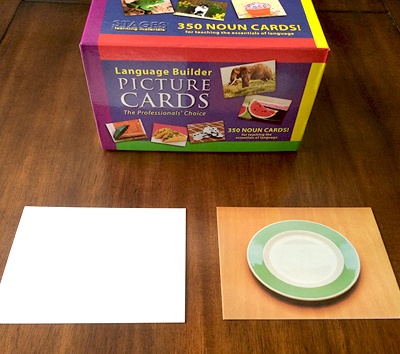Receptive Labeling Lesson Plan
Lesson Overview:
By touching or pointing to the appropriate card, students show that they recognize the word and can identify the corresponding picture. This activity can be prefaced by the Picture ID lesson to familiarize the student with the pictures he/she is finding.
Objective:
The student will demonstrate his/her receptive language labeling abilities by finding the card that corresponds with the word spoken by the teacher.
Skills Practiced:
- Receptive language
- Picture identification
- Photo discrimination
- Fine motor skills
Materials Needed:
-
Stages Learning Materials Language Builder Picture Cards.
People:
- This lesson is designed for 1:1 instruction with a teacher or therapist.
Set Up:
Decide which cards you would like to work on with your student. The Language Builder Cards can be separated by the following categories, making it easy to work on related vocabulary words in this lesson:
- Basic Stage Set
- Foods
- Animals
- Vehicles
- Clothing
- Furniture
- Toys
- Everyday Objects
- Colors
- Shapes
In this example, the teacher chose to use cards from the Everyday Objects category, but you can use any card(s) #1 – 301. Please note that for this activity (and all labeling activities using the Language Builder Cards), you should label the card by the word your student is most likely to hear and use in everyday speech. For example, say “sofa” rather than “couch”, or “TV” rather than “television.”
When your student is ready for distractor cards, cards #348, 349, and 350 have been left blank to be used for this purpose. Distractor words are the other words (not the target) that you put on the table from which your student will be able to choose. When your student is ready to move beyond blank distractor cards, any other image card may be used as a distractor, as long as a distractor image is not the same as your target! (For example, if your target word is apple you don’t want to use a different apple card as a distractor.
Sit with your student at a desk or table so that you can easily see your student and interact with the cards on the table. Depending on the student, you may choose to sit next to or across from him or her for best results. Have both blank and picture distractor cards ready.
Procedures:
Place one of the cards on the table facing your student. Hand your student the corresponding card and ask him or her to match the two. Your student can progress through 3 steps with this activity. Each will be detailed below, progressing from basic to more advanced:
Place only the target card on the table:
- Place a card on the table facing the student (for example, #255, the plate).
- Ask your student to give you, or to touch, the card in question.
- Try a phrase like, “Give me the plate” or, “Touch the plate.”
- When your student either gives you or touches the card, you know that he or she has received and understood the word.
- Try this activity again with the same card to ensure the student understands the activity.
- Move on to other target words (for example, the bowl, knife, and fork) and complete the same activity with the new cards.
Place the target card and a blank distractor card on the table:
- Place a card on the table, (for example, #255, the plate) along with a blank distractor card (cards # 348, 349, and 350 are blank for this purpose.) Both cards should be facing your student.
- Ask your student to give you, or to touch, the target card.
- Try a phrase like, “Give me the plate” or “Touch the plate.”
- When your student either gives you or touches the card, you know that he or she has received and understood the word.
- Try this activity several times while changing the position of the target card and distractor card. For example, if the target card is on the right, put it on the left next time. Or put the cards on top of each other.
- When your student either gives you or touches the target card, regardless of its position, you can feel even more confident that he or she has received and understood the word.
- Move on to other target words (for example, the bowl, knife, and fork) and complete the same activity with the new cards.
Place the target card and another picture card on the table:
 Place a card on the table, (for example, #255, the plate) along with another picture card (for example, #203, the boat). Both cards should be facing your student.
Place a card on the table, (for example, #255, the plate) along with another picture card (for example, #203, the boat). Both cards should be facing your student.- Ask your student to give you, or touch, the target card.
- Try a phrase like, “Give me the plate” or “Touch the plate”.
- Your student now has to distinguish the plate from the boat.
- When your student either gives you or touches the target card, you know that he or she has received and understood the word.
- Try this activity several times while changing the position of the target card and distractor card. For example, if the target card is on the right, put it on the left next time. Or put the cards on top of each other.
- When your student either gives you or touches the target card, regardless of its position, you can feel even more confident that he or she has received and understood the word.
- Also try changing the picture of the distractor word a few times. For example, use the picture of the boat, then switch to the picture of the chicken.
- Start with only one other distractor picture card on the table, then increase the number of other cards so your student will have to carefully study all of the cards before selecting the horse.
- Move on to other target words (for example, the bowl, knife, and fork) and complete the same activity with the new cards.
![]()

Jenna Wharff, Ed.M.
Jenna Wharff is a special education teacher at HOPEhouse at Cotting School, a transitional boarding school for students age 17-22 with special needs, in Lexington, MA. She specializes in helping her students prepare for life after high school by teaching independent living, vocational, and social skills as well as practical academics and providing opportunities for her students to apply what they have learned in the classroom to their everyday lives. She aims to help students and their families make the transition from special education to adult services as smooth as possible, while providing her students with the skills and knowledge necessary to lead productive and meaningful lives after leaving HOPEhouse. Jenna received her Master's degree in Mind, Brain, and Education from Harvard Graduate School of Education in 2007.






